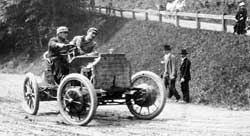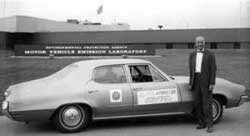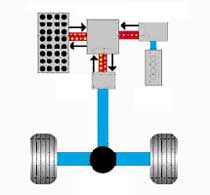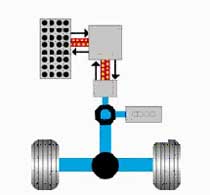Energy-Efficient Vehicles: The Hybrid Vehicle
One popular and successful energy-efficient vehicle is the hybrid. It contains both an internal combustion engine, powered by gasoline, and an electric motor, powered by batteries. Different vehicles use somewhat different arrangements to switch back and forth between the motor and the engine. But all hybrids do the same thing—alternate between gasoline power and battery power. Hybrids use less gasoline than regular vehicles and thus produce significantly fewer polluting emissions.
The hybrid’s electric motor gets its power from rechargeable batteries, but unlike electric vehicles, hybrids do not need to be plugged in to recharge. The batteries are recharged mostly by the combustion engine. Most hybrids also have two braking systems: traditional hydraulic brakes and a regenerative braking system. This means that the energy created by applying the brakes to stop the vehicle goes back to the batteries rather than being lost as heat from friction.
The most popular hybrids, including the Toyota Prius and the Honda Civic, are small cars. But automobile makers also have larger hybrid sedans, such as the Toyota Camry, and sport-utility vehicles, including the Ford Escape. However, most of the larger hybrids are not nearly as energy efficient as the smaller vehicles, because they contain larger combustion engines to provide more power and because they are larger cars overall.
Like electric vehicles, hybrids were developed early in automobile history. The first one was built by Ferdinand Porsche in 1900. This vehicle used an internal combustion engine to power a generator attached to electric motors in the wheel hubs, as well as a battery to store energy. In the early years of the automobile industry, a number of other hybrids were developed. But like the electric car, once Ford began to mass-produce internal combustion engine vehicles, the hybrid disappeared.
Development of the Modern Hybrid
|
The first hybrid automobile was built by Ferdinand Porsche in 1900, for Viennese coachmaker Lohner. It had a combustion engine as well as an electric hub motor and could store energy in a battery.
|
In 1974 engineers Victor Wouk (above, at the EPA test site) and Charlie Rosen built a gasoline and electric hybrid using a 1972 hybrid Buick Skylark. Although the car met strict emission standards, the engineers lost their financial backing from the EPA, and development was halted. |
Interest in hybrids resumed—along with the resurgence of interest in the electric car—in the 1970s. One of the first modern hybrids was built by American engineers Victor Wouk and Charlie Rosen in 1974. They converted a 1972 Buick Skylark to a hybrid. This vehicle was designed as part of the Clear Car Incentive Program from the U.S. Environmental Protection Agency. Funding for the program was discontinued, and the vehicle never went into production.
For the next ten or so years, there were two approaches taken to developing hybrids. In one, enterprising individuals figured out how to convert standard vehicles; if they got publicity, they shared plans with other interested parties. Or, a variety of companies also built unusual concept hybrid vehicles. One example was a six-wheeled, two-door vehicle built with a motor by Briggs & Stratton, best known for manufacturing engines for lawn mowers. In the late 1980s German automaker Audi built a car that had an internal combustion engine drive train for the front wheels and a battery-powered electric motor for the rear wheels.
|
The Honda Insight hybrid was redesigned in 2010, replacing an older, smaller model. |
This six-wheeled hatchback, built in 1980 by self-taught electric vehicle enthusiast Lou Gyogy, was powered by a Briggs & Stratton two-cylinder engine and an electric motor. |
The Toyota Prius has become a very popular vehicle in the United States. |
In early 1992 Japanese automaker Toyota announced a commitment to developing low-emission vehicles. The first of these was the hybrid Prius, which went on sale in Japan in 1997. Rival Japanese automaker Honda introduced its hybrid, the two-door Insight, in the United States in 1999. Toyota brought the four-door Prius to the United States in 2000. Honda phased out the Insight in 2006, but brought back the name in a much-revamped version in for the 2010 model year. The company introduced a hybrid version of its popular Civic in 2002. The Japanese hybrids were a success, and other automakers followed them into the hybrid market. The first American hybrid was a version of the Ford Escape, a small sport-utility vehicle, introduced in 2004. Since then, even larger hybrids have become available. However, the smaller ones remain the most economical and least polluting.
What’s Inside the Hybrid?
|
A series hybrid uses an internal combustion engine to power a generator, which in turn drives the electric motor. The motor powers the drive train or recharges batteries. |
A parallel hybrid is designed to let the electric motor and the gasoline engine operate at the same time. |
Not all hybrids are equal. Different types of drive trains produce somewhat different results in terms of energy efficiency. In a series hybrid, an internal combustion engine turns a generator. The generator can power the electric motor that powers the drive train or it can recharge the batteries.
In a parallel hybrid, the gasoline-fueled internal combustion engine and the battery-powered electric motor can both power the transmission at the same time.
The parallel hybrid uses a small 4-cylinder engine, increasing fuel economy. However, the small engine does not provide the level of instant power many drivers usually have in a typical vehicle.
The combination drive train unites the best features of both previous types. Both the internal combustion engine and the electric motor can power the car. A computer in the car determines which one to use at all times. The electric motor is the main motor at lower speeds. At higher speeds, if extra power is needed, or if the batteries need to be recharged, then the internal combustion engine takes over. This makes the most efficient use of the gasoline.
There are also different levels of hybrid-ness. A full hybrid, such as the Toyota Prius, or the Ford Escape, runs on the internal combustion engine, the electric motor, or both at any given time. This results in significantly reduced gasoline consumption and thus significantly reduced emissions. An assist hybrid uses the electric motor to help the combustion engine. This also reduces gasoline consumption by a notable amount. Honda uses this system in its Civic hybrid. A mild hybrid uses the electric motor as a power booster for the combustion engine, but the electric motor can never be used by itself. The Saturn Vue hybrid is a mild hybrid, with slightly reduced gasoline consumption.
|
Swedish auto maker Volvo is among the companies developing plug-in hybrids. |
Batteries are an important component of the hybrid. Current models use nickel-metal hydride batteries, which are significantly more expensive than typical automobile batteries. Because of this, automakers have provided extended warranties of 128,750 to 160,95 km (80,000 to 100,000 mi) on the batteries.
Still in development are plug-in hybrid electric vehicles (PHEVs). Automakers around the world are working on hybrids that require very little gasoline. They use larger batteries and thus can go farther on the electric motor. They recharge with electricity, rather than from the combustion engine. So far, the prototypes are still being tested.
This content has been re-published with permission from SEED. Copyright © 2025 Schlumberger Excellence in Education Development (SEED), Inc.









